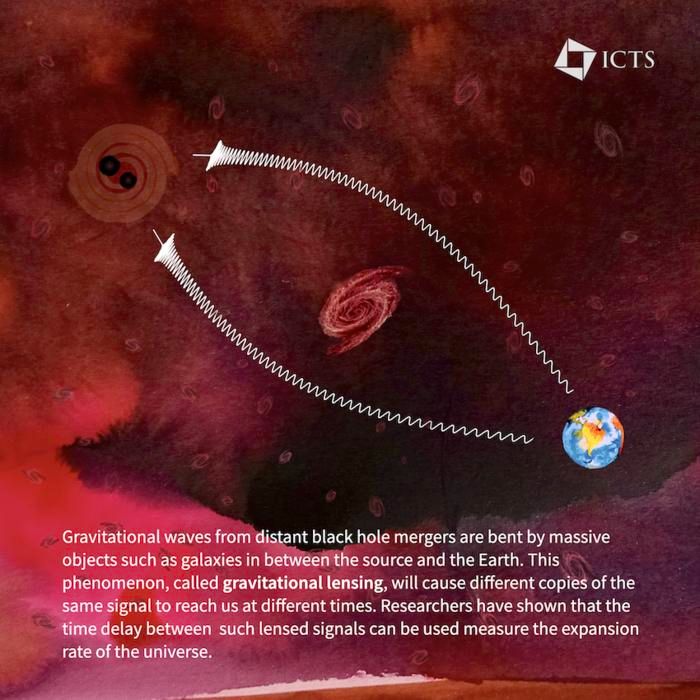In 1929, astronomers found that galaxies were moving away from Earth and each other. They inferred from this observation that the universe is growing. Nevertheless, when they measured how quickly it was expanding, they obtained different solutions with the use of different methods. This variation remains a thorn in their hypothesis of a growing universe.

Strong Lensing of Gravitational Waves. Image Credit: Parameswaran Ajith (ICTS)
A group of scientists headed by Souvik Jana at the International Centre for Theoretical Sciences, Bengaluru, have suggested a solution. Their study, to be published in the journal Physical Review Letters, has been chosen as an Editor’s suggestion.
The answer centers on learning more about gravitational waves, ripples in spacetime, which astronomers first detected in 2015. The research group investigated how gravity itself impacts gravitational waves.
As pairs of black holes combine to form a single black hole in a cosmic dance, they release gravitational waves. Upon reaching the Earth, kilometer-length detectors aid researchers in examining the characteristics of the black hole pairs. Huge galaxies taking up the space between the Earth and the black holes alter the paths of these spacetime ripples, which result in the detectors recording several replicas of the same waves. Astronomers name this phenomenon gravitational lensing.
We have been observing the gravitational lensing of light for over a century. We expect the first observation of lensed gravitational waves in the next few years!
Parameswaran Ajith, Study Co-Author, Tata Institute of Fundamental Research
In the next 20 years, researchers will begin running sophisticated gravitational wave detectors looking for the merging black holes.
“Future detectors will be able to see out to much larger distances than the existing ones,” described Shasvath J. Kapadia, from the Inter-University Centre for Astronomy and Astrophysics in Pune, who is also one of the co-authors of the study. Tejaswi Venumadhav from the University of California at Santa Barbara, another co-author, stated they could sense weaker gravitational wave signals, which get buried in the noise impacting existing detectors.
Astronomers approximate that the state-of-the-art detectors will record signals from some million black hole pairs, all merging to create a huge black hole. Among these, around 10,000 black hole mergers will show up more than one time in the same detector owing to gravitational lensing.
The research group headed by Souvik established that by quantifying the number of such repeat black hole mergers and examining the delay between them, they can quantify the expansion rate of the universe. As the data from sophisticated gravitational wave detectors drop through the next 20 years, their approach can possibly measure the expansion rate of the universe precisely.
Souvik stated that the research group’s proposal does not need to know the characteristics of the individual galaxies that make up the distances to the black hole pairs, several copies of gravitational waves, or even their precise location in the sky. Rather, it just needs a precise approach to recognizing which signals are lensed. Researchers are enhancing their methods to find the repeat signals, states Shasvath.
Gravitational lensing needs the astronomical source to be distant. The black hole pairs suit this condition, originating a whopping 13.3 billion years ago, hardly 500 million years old following the birth of the universe.
Shasvath cautions that their suggested approach will be of use only when the sophisticated detectors record millions of black hole mergers. At present, the research group is learning how such a forthcoming observation will have the potential to tell apart various models of the universe that cosmologists have suggested.
The team explained that the study tried to answer mysteries of the elusive dark matter, which is a type of matter that does not communicate with light. The dark matter theory resolves the astronomer’s concern about describing why galaxies have the observed mass. Nevertheless, researchers are still unclear of the dark matter’s properties, resulting in different dark matter models.
The team's ongoing research proposes that future observations of lensed gravitational waves will act as a tool to examine dark matter.
Journal Reference
Jana, S., et al. (2023) Cosmography Using Strongly Lensed Gravitational Waves from Binary Black Holes. Physical Review Letters. dx.doi.org/10.1103/PhysRevLett.130.261401.